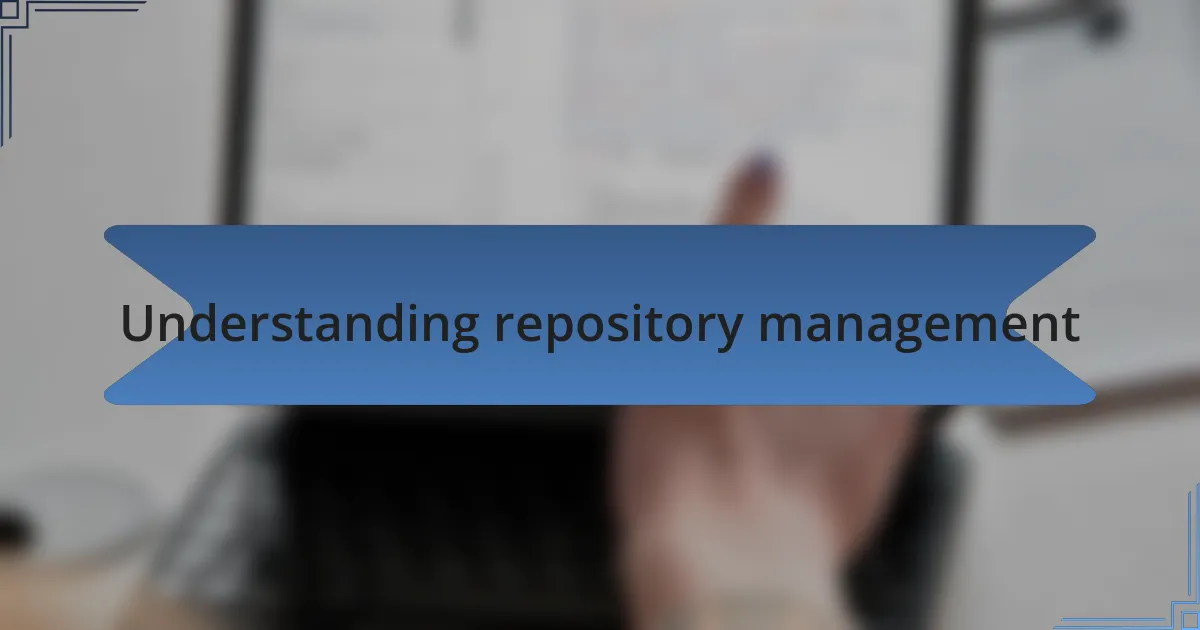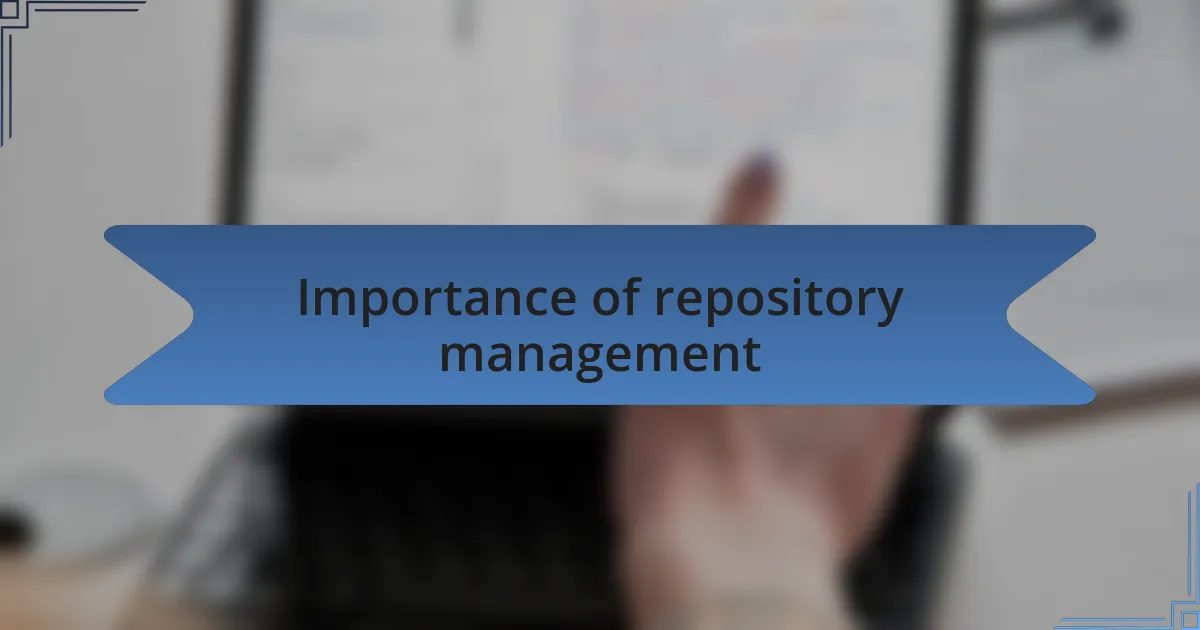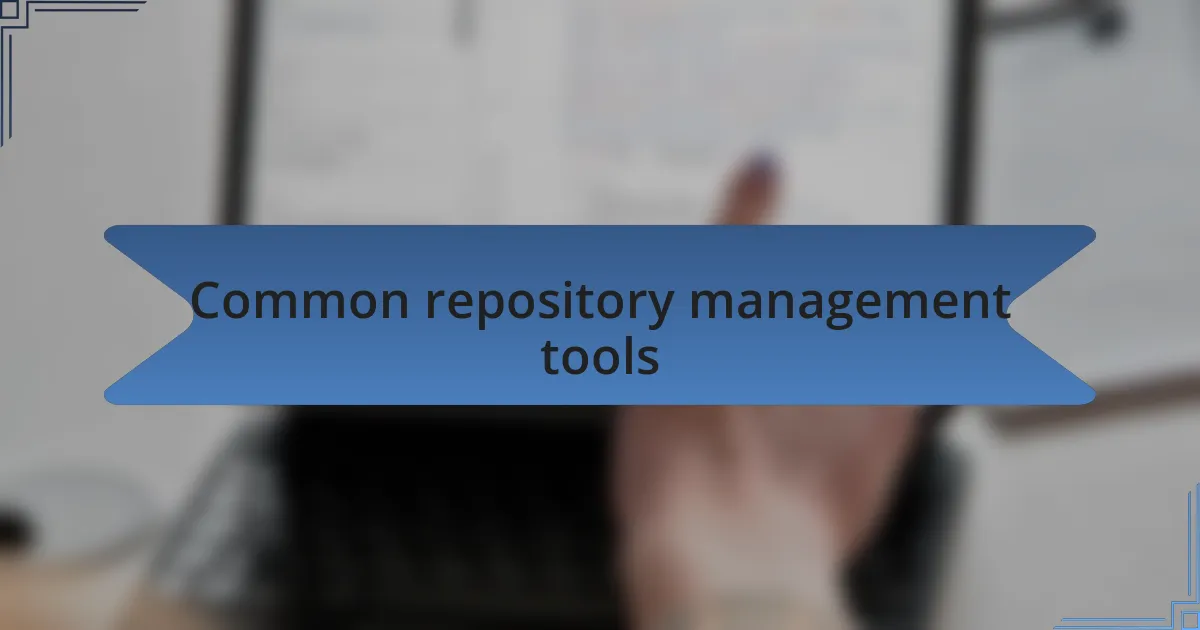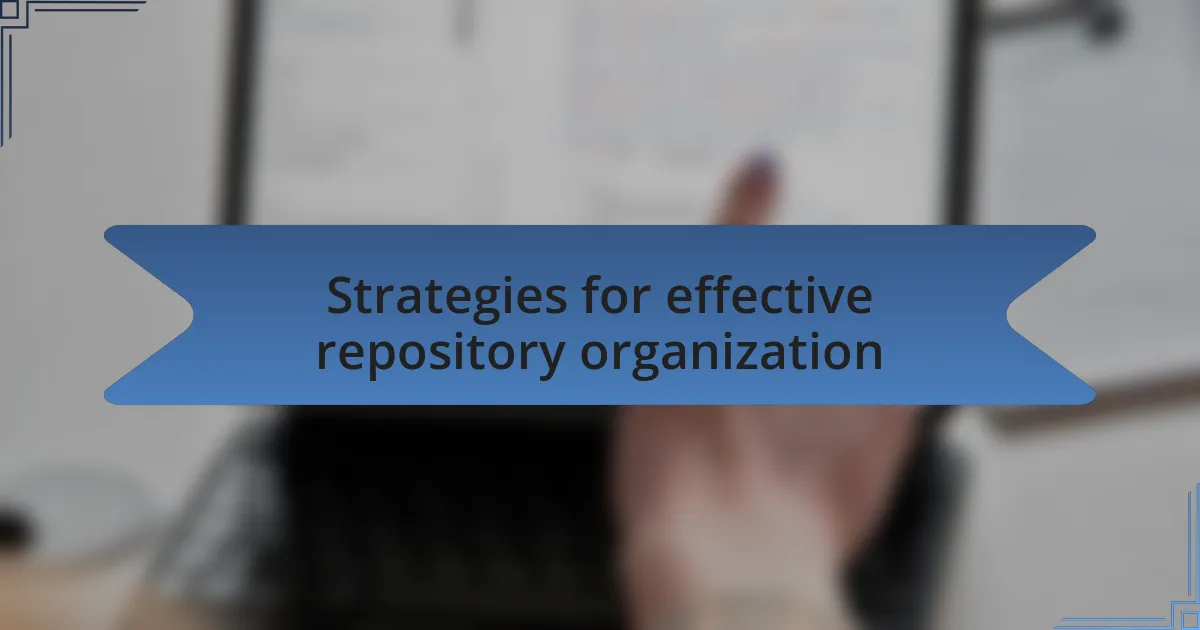Key takeaways:
- Effective repository management enhances collaboration, code quality, and team morale.
- Clear naming conventions and directory structures significantly improve organization and efficiency.
- Regular maintenance and clear communication are crucial to avoid confusion and merge conflicts.
- Thorough onboarding and code reviews are vital for integrating new members and ensuring high-quality work.

Understanding repository management
Repository management is the backbone of software development, acting as the central hub where code is stored, versioned, and collaborated on. I remember my first experience with version control—it felt overwhelming to manage multiple branches and pull requests. But that initial confusion transformed into a sense of empowerment as I realized how organized and efficient my workflow became.
Managing a repository isn’t just about keeping code in check; it’s also about fostering collaboration among team members. I once worked on a project where communication broke down because of poorly managed repositories. This made me appreciate the importance of clear branching strategies and commit messages. How can we expect smooth teamwork without clarity in our versioning methods?
The emotional aspect of repository management can’t be overlooked either. When I see a well-maintained repository, it gives me a sense of pride. It’s a reflection of the dedication and discipline of the entire team. Have you ever felt that rush of satisfaction when everything in the repository just clicks together? That’s the beauty of effective repository management—it captures not just code, but also the collective effort and commitment of everyone involved.

Importance of repository management
The importance of repository management cannot be overstated, especially when it comes to ensuring code quality and maintainability. I recall a project where an early lack of structure led to serious bugs that knocked our timeline off course. It was a valuable lesson; effective repository management allowed us to identify and fix issues quickly, drastically reducing development time in future projects.
Moreover, having a well-organized repository can enhance the onboarding experience for new team members. I remember when I joined a team with a clear and intuitive repository structure; I felt welcomed and capable right from the start. It’s fascinating to think how such organization can significantly impact team morale and productivity. Do you think a newcomer would feel the same way in a chaotic repository?
Ultimately, repository management can be seen as a reflection of the team’s culture. When I work with teams that prioritize structured repositories, it fosters a mindset of accountability and professionalism. It’s rewarding to witness how this attention to detail translates into smoother processes and ultimately, successful project outcomes. Don’t you believe that a well-kept repository can be a testament to a team’s dedication to excellence?

Common repository management tools
When discussing common repository management tools, Git is often at the forefront of the conversation. I remember when I first started using Git; its branching and merging capabilities amazed me. It allowed my team to work simultaneously on features without the fear of overwriting each other’s changes. Have you experienced that feeling of security when knowing your work can be seamlessly integrated?
Another essential tool that I frequently utilize is GitHub. It’s not just a platform for hosting code; the collaborative features, such as pull requests and code reviews, are game changers. Reflecting on my experiences, those features have elevated our code quality substantially, as team members can catch potential issues before they become problems. Isn’t it reassuring to have a safeguard in place where peers can offer insights?
Bitbucket also deserves a mention for its user-friendly interface and integration with Jira. I’ve found that the seamless connection between project management and repository hosting can streamline workflows remarkably. In fact, I still recall a specific project where using Bitbucket enhanced our ability to track issues right alongside our code commits. Doesn’t it feel great when the tools you use synchronize so effortlessly?

My selection criteria for tools
When selecting repository management tools, I focus on several key criteria that resonate with my practical experiences. First and foremost, I look for ease of use. I vividly remember spending hours wrestling with tools that had a steep learning curve. The moment I found a user-friendly option, it was like a breath of fresh air, allowing me to focus on my projects rather than getting bogged down by technicalities. Have you noticed how the right tool can make each task feel more enjoyable?
Another critical factor for me is the level of collaboration a tool supports. I once worked on a project that suffered setbacks due to inadequate communication channels among team members. Since then, I prioritize tools that facilitate real-time interactions, such as commenting directly on code lines. Isn’t it satisfying when discussions happen within the context of the work itself, creating a more cohesive workflow?
Lastly, I always assess the integration capabilities of any tool I’m considering. I recall a time when a tool I chose didn’t sync well with our existing project management software. It created unnecessary friction and wasted time. Now, I ensure that any selected tool can integrate seamlessly with others in my tech stack. Shouldn’t our tools work together to enhance productivity, rather than act as roadblocks?

Strategies for effective repository organization
When it comes to organizing repositories effectively, I’ve found that adopting a clear naming convention is crucial. Early in my career, I often encountered confusion due to inconsistent naming. I remember one project where I spent so much time figuring out which file was the latest version. Now, I prefer systematic naming that incorporates dates and versions. Can you imagine the time saved when everyone knows exactly what to expect from a file name?
A well-structured directory hierarchy is another strategy that has transformed my repository management. I learned this lesson the hard way during a group project where files were scattered without logical grouping. It took hours to locate essential resources. By organizing files into distinct folders, like separating documentation from source code, I’ve made it much easier for both myself and my team to navigate. Have you ever felt the relief of finding everything exactly where you expect it to be?
Regular maintenance of repositories should not be overlooked either. Initially, I was hesitant to allocate time for this, thinking it was unnecessary. But when I began scheduling periodic reviews, I discovered outdated branches and files that cluttered my projects. Maintaining a tidy repository, through practices like archiving old branches or removing unused files, not only boosts efficiency but also enhances clarity. Isn’t it remarkable how a little upkeep can lead to smoother working processes?

Challenges faced in repository management
Navigating repository management often presents unique challenges that can frustrate even the most seasoned developers. I vividly recall a situation where I faced merge conflicts that arose from multiple team members working on the same files simultaneously. The tension in the air was palpable as we scrambled to resolve discrepancies, and I thought, how could something so small create such chaos? It became clear to me that a lack of clear communication and collaboration strategies can derail even the best-planned projects.
Another issue that surfaced in my repository management journey was dealing with permissions and access controls. In one instance, I accidentally granted access to sensitive parts of our codebase to a new intern who wasn’t fully trained yet. The anxiety I felt when I realized the implications was intense. This experience taught me the importance of implementing a structured access control system right from the start. How often do we underestimate the risks that come with improper access management?
Lastly, ensuring consistent code quality and documentation has been a persistent struggle. I remember joining a project where documentation was sparse, leading to misunderstandings about code functionality and integration. It’s frustrating when you want to build on someone else’s work but can’t decipher their logic. I’ve found that investing time in creating clear documentation and encouraging code reviews enhances not just repository management but also fosters a collaborative environment. Wouldn’t we all agree that well-documented code is a key to smoother collaborations?

Lessons learned from my approach
One of the most significant lessons I learned is the power of clear communication. I once jumped into a project where my assumptions about team workflows led to a disjointed experience. Many of us fell into the trap of “just putting it in the repository,” believing everyone would figure it out. It was a humbling moment when I realized that without a solid structure for sharing updates, we were essentially working in silos. How often do we overlook the basic need for ongoing dialogue?
Another crucial takeaway was the necessity of thorough onboarding processes for new team members. I vividly remember the frustration of a new developer struggling to find their footing. They missed essential links and processes that were second nature to the rest of us. This experience reinforced the idea that a well-defined onboarding checklist can save hours of confusion and make newcomers feel like valued contributors from day one. Isn’t it fascinating how such a simple strategy can significantly impact team integration?
Lastly, I discovered the importance of regular code reviews. Early in my career, I feared receiving feedback, thinking it might reflect poorly on my abilities. However, I soon learned that constructive criticism was a catalyst for growth. I recall an instance where a colleague’s insightful critique opened my eyes to better coding practices, which ultimately led to a more reliable product. Embracing this practice not only reinforced quality but also nurtured mutual respect within the team. Isn’t it incredible how sharing knowledge can elevate everyone involved?